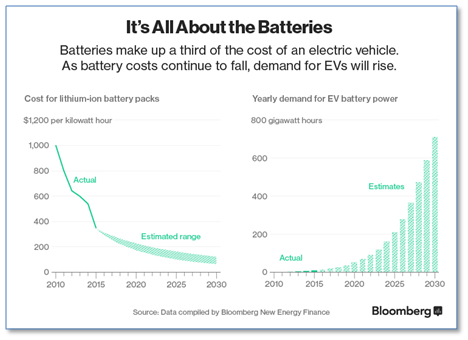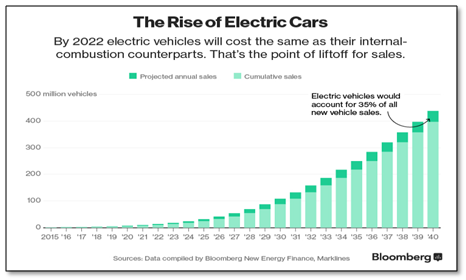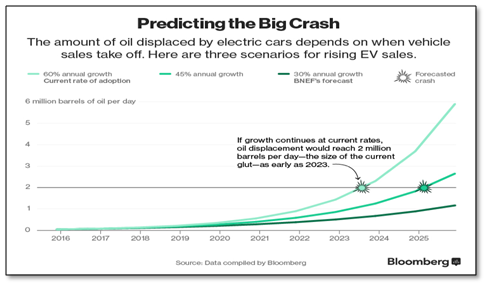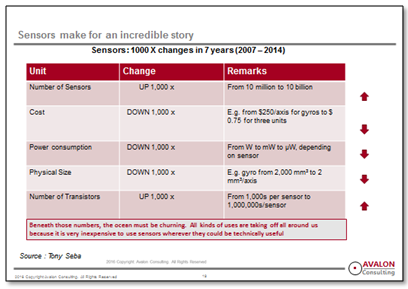[The article below was originally an Institute lecture given by the author on August 3, 2017. Here’s the link to the video recording.]
Thank you for giving me the opportunity to deliver this prestigious Institute Lecture. I will not indulge in speculative technology forecasting but all the same, transport you into the future, because the kind of research projects or non-academic careers that you could choose may change if you knew some aspects of the future with a degree of certainty. I will demonstrate that you can even today see many of the things that will, probably, happen in a few years. You just need to identify important technological developments that have already happened and then study their impact, when adopted in specific fields, and then, study the impact of those things on things that lie further downstream. My interest in these things started one summer night in Aberdeen in 2007 when I heard on TV that a British Bank, Northern Rock had collapsed suddenly due to investments in CDS (Collateral Default Swaps), an instrument that most people had not heard of till then. I wondered how things could have been different for hapless investors, if this collapse could have been anticipated. Research led me to understand that Banks were speculating in that instrument and that it was being used by Bankers in the US to create multiple layers of pseudo assets built on poor quality loans given to people with doubtful credit history. After understanding the chain of events backwards from Northern Rock’s collapse to the root cause, I found that if one had worked forward from when reckless trading in naked CDSs had started, it would have been possible to predict the Northern Rock collapse. This thought enthused me to use the same process in the forward direction starting with the then situation, and that led me to believe that the entire global economy will collapse in the next year. I gave talks on this at various public forums from November 2007 until March 2008 by which time the fault-lines became self-evident and the collapse happened in July 2008. Then onwards, for the past decade, I have been using this very simple process of deductive logic for predicting the future after identifying things that can trigger change- social trends, politics and technology amongst many others. That is the secret behind predicting that oil price would collapse in 2008 whilst the general opinion, including that of Goldman Sachs, was that it would rise from $140 per barrel to $180.
Back in 2016, I predicted a few things to a group of top business leaders in Mumbai. They argued because it went against conventional wisdom. Since it is old hat today, I will just mention them as a reference point for the next set of predictions.
- Many of the ‘under-the-hood’ Auto-component manufacturers, and, also the automobile engine lube business will be in trouble in about 10 years and rapidly decline thereafter. It seemed like a crazy statement to make given that the IBEF had predicted that India’s auto component i
 ndustry’s exports will rise from $11.2 billion to at least $80 billion by 2026.
ndustry’s exports will rise from $11.2 billion to at least $80 billion by 2026. - No new petrol and diesel engine cars, hybrid or otherwise, will be produced in just 14 years from now. It was strange given that debate globally was on efficient petrol vs. diesel engine and that the venerable Fleet News had published a survey that 79% of car owners in the UK believe that by 2030 most cars would be hybrids.
- Many people will not even bother to own a car in 10 years. It seemed like a crazy statement to make given that a serious study by the International Energy Agency had predicted that car ownership in India will grow 775% by 2040 over the base in 2016.
- Oil price could drop to $12-15 per barrel in about 7 years. This sounded confusing given that the World Bank had predicted a price of $80 per barrel in 2024.
- Aluminum conductors, transmission line towers, insulators, and other related products in the long-distance power transmission industry, etc. will suffer demand drop in 10 years. How could this happen when the Government was talking about doubling the investments in generation, transmission and distribution?
- It will make no sense to put up large conventional Power plants in less than 5 years: Massive investments were being planned in power plants and further downstream.
There are many more believers in these predictions in 2017 than there were back then.
While most tech giants are scrambling to deploy AI in their processes and products, we have Zuckerberg who believes that AI will create endless opportunities for mankind while Musk is afraid that AI and Robots will take away human jobs to the extent that we will be left with a huge problem of not just unemployment but also the fear that Robots could become the enemy of humans.
Today, I will take off from this controversy stoked by Elon Musk and Mark Zuckerberg and move on to how the changes that you will witness in many fields are going to shape the direction in which Academia, Research, Industry and even careers are likely to move. It will help you to think of what you and the Institute may want to do, in order, to get ahead of the race in the future.
Several conventional jobs which require rule-based decisions and actions, repetitive work, etc. will get obsolete as Elon Musk predicts, yet I am inclined to agree with Zuckerberg. New opportunities will appear in new fields. When the automobiles replaced horse carriages, many people bemoaned the loss of jobs amongst carpenters and carriage drivers.In a short span of 15 years, far more jobs were created than were lost, road networks expanded and a huge number of automobiles were produced. Years later, it was felt that computers would cause widespread job losses. The Government of Kerala had even discouraged the use of computers at one time but today there is a thriving software industry in Kerala providing services, products, animation, etc. to the world! This time it is different because job losses will be across sectors and probably simultaneously. So where could the opportunities for new jobs lie? I will come to that soon but let me take you through a few examples of massive change that could have been anticipated last year if we could have trained our minds to go beyond understanding the connection between an action and its direct outcome. In the real world, most outcomes are the result of multistage non-linear events with more than one event feeding the other. Often the root cause is 3 to 5 levels away from the final effect that surprises you. That also makes it difficult for the human mind to correctly estimate the time taken for change to happen because mental heuristics require the outcome to be somewhat visible or at least imaginable.
I have selected only a few technologies out of over 20 to explain why technology is set to disrupt many industries and businesses in the next decade leading to a future that is not generally expected. I hope that you will go back and look at the world differently and start looking at the future of your field of study/research or your industry somewhat differently.The opportunities for you as students, as faculty and even for IIT will be quite different from what you think.
Technology has disrupted industries in the past too but we have short memories. Like the horse-cart, many other things have disappeared, for example, the Black & White TVs, large clunky main frame computers, Nokia feature phones, inkpots, winding watches, etc. Kodak, the fifth most valuable company on the planet in 1996, with huge access to cash and technology, was wiped out 16 years later because they could not read the future correctly.
Whenever an industry grows extremely rapidly, it means that something big is happening and many big things will follow. Show me how many industries have grown at such a scorching rate as these three- Li-Ion Batteries, Solar Energy and Sensors?
Let me start with batteries. Their use is increasing very rapidly because devices are becoming mobile very fast and consequently, more R&D, better manufacturing at big scale, etc. are resulting in falling prices as can be seen in the chart. What is not so obvious is that this will disrupt several other industries besides EV which Bloomberg has predicted. Even large-scale storage for Non-Conventional energy will change.
Li-Ion batteries prices slid from $1000 per KWH in 2010 to below $300 in 2016. This process of reducing costs will go on for a long time for some technology limits of Li-Ion batteries have not been hit yet. In the meanwhile, at UT Austin, the 94-year-old, co-inventor of Li-Ion batteries, Dr Goodenough, is now working on a new type of solid electrolyte based battery based on Sodium which is cheaper and more widely available than Lithium. That is very good news for all of us, but not for China and South America where Lithium is mined. These Sodium ion batteries have another important property-they can be charged rapidly, which is an important requirement in transportation and hand-held devices. It uses a solid glass electrolyte instead of a liquid electrolyte. Metal dendrites that form during rapid charging in a liquid electrolyte resulting in short-circuits and explosion, prevent rapid charging of Li-Ion batteries. That does not happen in a solid electrolyte system.
Even if the cost of the batteries drops at the current rate, it will fall below $100 per KWh by 2020 which will make it possible to theoretically replace petrol & diesel engines in cars completely. High cost of batteries which make up a very large component of the cost, made an EV unviable in the past. Soon EVs will be sold at no more than the price of conventional IC engine cars. This could have been anticipated even in 2014 but most people did not accept this possibility until recently. Tesla Model 3 was launched just a few days ago at a price of $ 35000 which is the price of an average car in the US. It can do more than 200 miles (320 km) per charge, which is important for EVs to go mainstream.
 Bloomberg expects 35% of all new cars in 2040 to be EVs (see Chart below) whereas I expect a 100% shift in new car production to EV as early as 2030. There are others with more aggressive forecasts than mine.
Bloomberg expects 35% of all new cars in 2040 to be EVs (see Chart below) whereas I expect a 100% shift in new car production to EV as early as 2030. There are others with more aggressive forecasts than mine.
Further, I believe that there will be a huge opportunity for developing conversion kits for existing vehicles which will be a combination of software and hardware- battery, governor and electric motor. I wonder whether prototype EV conversion kits are not already being designed here at IIT Bombay. There will also be an opportunity to develop smart charging stations which can charge a battery or at least top up the charge in seconds rather than in hours.They will dot the roadways and even housing complexes in a few years from now and will replace petrol pumps eventually.
If the production of new cars completely shifts to EVs in 2030, there will be a drop in demand for oil to the extent of nearly 5.7 million barrels per day,and if individual OPEC countries keep fighting with each other to maintain levels of oil production, the oil price can slide to about $12-15 per barrel. Much before that, may be by 2021, the demand for oil from the automobile industry may drop by about 1.5 to 2 billion barrels per day. If that happens you may see oil prices dropping to $ 20-25 per barrel because by then the EV story will be clearly visible and probably the shale oil extraction technology would have cut costs further. 
It may be argued that these Lior Na Ion batteries need to be charged every day with electricity to be generated using petroleum or other fossil fuels.
Here is another bad news for oil. While all this is happening to batteries, the installed cost of Solar photo voltaic cells has dropped to $2 per W (An 80% drop between 2011 and 2016) and is expected to become even cheaper than $1 per W by 2020.
Soon there will be many solar charging stations for EVs and EVs may not have to depend upon electricity from the grid. I have seen a few in the US on a recent visit. Batteries may even get charged with solar cells on car roofs and bonnets. With Na-Ion batteries the charging will become very quick too. I am reminded of the Na-Zn battery that propelled the Nautilus in Jules Verne’s novel, ‘Twenty Thousand Leagues Under The Sea’. He imagined it in 1867 and preferred Na because of its high emf.
Do you know that a successful experiment has been done to light up an entire French village using solar cells laid directly on the main road passing through the village?
Therefore, the use of oil as transportation fuel has a bleak future and therefore, the number of oil tankers crossing the seas will drop. The GCC may not be the economic oasis that it was just 3 years ago. Unless the ME turns into a global hub for producing value added petrochemicals instead of exporting oil, the economies of those OPEC countries will get decimated and India’s export of labour to the ME will also decline. Inward remittances will drop and Banks will lose a lucrative source of income. That is the least of the problems for Banks, which I will come to later.
Let us now look at Sensors whose technology has come of age. There are different types of sensors which can see, taste, hear, smell and feel. Sensors can make everything smart, from phones and toothbrushes to cars and even Johnny Walker smart whisky bottles. How about a charger for your smart phone that picks up energy from your movement when you walk or jog? It was displayed at CES 2016. Once sensors are combined with Artificial Intelligence software, they can make any device act nearly like human beings. This is not science fiction.
 There is a massive explosion in the market for smart sensors, a sub-set of the overall sensor market which is also growing. The former is expected to grow to $10.5 billion in 2020, a growth of 36% CAGR in value terms, despite,massive simultaneous price reduction. The demand grew 1000 X between 2007 and 2014. Can you imagine another industry like that? Beneath those numbers, the ocean must be churning. All kinds of uses are taking off all around us because it is very inexpensive. Google, Apple, Tesla and even Nissan are testing driverless cars using sophisticated sensors. The first commercial run of an autonomous truck happened when Budweiser beer was transported across California in November 2016. Many months earlier driverless taxis started in Singapore. Uber has big plans. Imagine what will happen to drivers when more mainstream car companies like GM, Ford, Toyota, etc. join Tesla, Apple & Google to make autonomous vehicles. The car driver profession will go the way the horse cart driver’s job went a hundred years ago. It may exist for few more decades in India but the writing is on the wall.
There is a massive explosion in the market for smart sensors, a sub-set of the overall sensor market which is also growing. The former is expected to grow to $10.5 billion in 2020, a growth of 36% CAGR in value terms, despite,massive simultaneous price reduction. The demand grew 1000 X between 2007 and 2014. Can you imagine another industry like that? Beneath those numbers, the ocean must be churning. All kinds of uses are taking off all around us because it is very inexpensive. Google, Apple, Tesla and even Nissan are testing driverless cars using sophisticated sensors. The first commercial run of an autonomous truck happened when Budweiser beer was transported across California in November 2016. Many months earlier driverless taxis started in Singapore. Uber has big plans. Imagine what will happen to drivers when more mainstream car companies like GM, Ford, Toyota, etc. join Tesla, Apple & Google to make autonomous vehicles. The car driver profession will go the way the horse cart driver’s job went a hundred years ago. It may exist for few more decades in India but the writing is on the wall.
Even today, with just Uber and Ola, it is uneconomical to have a car and driver in India. Why would any of you want to own a car in the next 5 to 10 years, if you can get your choice of vehicle to suit the occasion, and, at your convenience with a driver? Not just Uber and Google, but even car manufacturers are thinking of a new business model – offering autonomous cars as a service rather than selling cars. By the way, General Motors have already invested in Uber’s competitor, Lyft, with that in mind. What does this mean in terms of research and job opportunities for technology folks?
Spare a thought for the huge auto component industry if there is no production of cars with petrol or diesel engines! It is a $700 billion industry globally. A lot of under the hood components will disappear and will be replaced by fewer new components when EVs displace conventional vehicles. Some say 90% of those components will be gone. Not required anymore! This will also impact auto repair shops which will now need to deal with motors and other electrical & electronic components as opposed to mechanical parts. Actually automobile lubes (except for braking fluids) will get impacted. Think of Castrol. A part of their product portfolio will go but the good news for them is that petrochemicals, one of their raw materials will get cheaper because oil prices will fall.
Since that is going to happen, Chemical and Material Science engineers can start thinking of applications that were hitherto not feasible.
Allow me to switch to power utilities. We have a generating capacity of 3.02 lakh MW in India, some additions are on the way and some capacity is lying idle due to want of fuel linkages and other reasons. Most power generating utilities and distribution companies depend upon demand charges. If that disappears, the energy charges will not be sufficient to give them profits. With low cost Li and Na-Ion batteries, it will be cheaper to charge the batteries when the cost of power is low and use stored power, when your power requirement peaks.You might say that since there is no time of day’ pricing in India, we don’t have that problem. When the cost of generating solar power drops to below Rs. 2 per KWH, why would anyone want to buy thermal or hydel power at between twice to five times that price? The startling fact is that the cost of solar energy without Government subsidy is set to become lower than even the cost of transmitting power to the user from the generating plant by 2025. Therefore, even if power is generated at zero cost at a power plant, it will not be able to compete with localized solar power. This means that many inefficient power plants will be moth balled and no new conventional energy power plants will come up after a certain date. It also means that the demand for power transmission products will drop quite severely in another 10 years. E.g. transmission towers, certain types of aluminum and copper cables, etc. Germany’s plan is to generate 80% of its electricity from renewable sources, largely solar and wind, by 2050. Many others including India, are contemplating moves like that. It is not for nothing that Modi is pushing heavily for solar energy.
It is also predicted that EVs could become ‘power storage plants on wheels’ by combining solar PV with new battery technology, enough power to light up small towns. This is not fantasy.
A few weeks back in July, Tesla signed a contract with Australia to supply a 100 MW Lithium-Ion battery system in 100 days flat to offset the power shortages that have resulted from the decision to shift away from polluting power plants. Is this going to set a trend globally? In that case, even existing thermal power plants may get mothballed. That will be good for the environment if the batteries are going to be charged with renewable energy but it will surely affect coal demand. Think of the industries that depend upon coal mining. Manufacturers of huge excavators, dumpers, etc. and in turn, manufacturers of components, large tyres as well as mining companies, shipping lines carrying coal, etc. will have a big problem. You certainly don’t want to buy shares in those companies.
This will also contribute to the lowering of demand for oil and gas because of which price of oil will drop substantially. Another consequence is that there will be a massive reduction in greenhouse gases and particulate matter pollution once solar energy generation replaces large parts of conventional energy and when cars switch to EV. Hence our future generations can hope to breathe clean air. Imagine what will happen to the multibillion dollar industry that produces pollution control devices and consumables (bag filters to catalytic convertors).

Photograph by Clint Adair
Let me move to Materials Science. For decades, the world discovered materials painstakingly almost one at a time and tested them to discover their properties. This constrained users whose products were limited by the material available. That process is about to be reversed. You will soon be able to start with an application in mind which requires certain structural properties like tensile or ductile or compressive strength or whatever, and a set of functional properties like heat resistance, electrical conductivity, etc.; then look up a database of materials that can be created to match the desired properties after which, the desired materials can be synthesized. A new field called Computational Materials Science is making all this possible.
A lot has happened, since John Pope used his concepts of quantum mechanics and super-computers in the early days of computational materials science. Inspired by the possibilities created in healthcare by discoveries in Human genomics, Gerbrand Ceder, a materials scientist at the University of California, Berkeley attempted the same with materials. Nicola Marzari in Lausanne, Switzerland, Stefano Curtarolo at Duke University and many others in the US, Europe and even China are heavily involved in taking it to the next level by harnessing advances in AI, the massive computation power available today and access to the work done in the past in physics and chemistry in labs all over the World. There are 3 well-known databases already available to materials scientists and many smaller specialised ones too.
Since access to performance materials is going to be of strategic importance, shouldn’t India play a role? It is predicted that there will be a whole slew of new materials for industrial use by 2026. What would it take for IIT Bombay to create a multi-departmental team to enter this field? Imagine the potential for students and faculty to work on this strategically important field which draws strengths from Computer Science, Materials Science, Civil Engineering, Chemistry & Chemical Engineering, Physics, Math and God knows what else.
Additive manufacturing
Another interesting area is Additive Manufacturing or 3D Printing as it is popularly called, which was originally designed for rapid prototyping and not for rapid mass manufacturing. When the internet and computing progressed and got cheaper, it found applications in low volume, customised production and production in remote locations. That niche itself was a $5 billion business in 2015 and is expected to grow four-fold in 5 years to $20 billion by 2020. Additive manufacturing could make it possible for factories located at faraway places to make critical spare parts very quickly without waiting for the supplier.
- Ceder and Persson’s Materials Project has a growing database of material constructs.
- AFLOWlib which Stefano Curtarolo is associated with, is the largest database with more than a million different materials including currently impractical transient ones, and it can be searched for nearly 100 million properties.
- Wolverton’s Open Quantum Materials Database (OQMD) includes around 400,000 hypothetical materials: You can download the entire database, not just individual search results, onto your computer to do research and not do searches on the OQMD host computer.
- There are many others like Marzary’s Computational Cloud for 2 dimensional materials which may have150,000 candidate materials by now.
The real fun for R&D is not just in making smarter machines that can be used for various niche applications but to figure out a way for this ‘rapid prototyping’ technology to get into the realms of ‘rapid mass manufacturing’. This sector could grow 50-fold in 5 years and keep still keep growing once that is done. This will involve not just improving the physical constraints in the process with better designs of pinch wheel mechanism, the feed rate, etc. but also improving the process speed itself using robots with self-learning algorithms and cameras to capture defects that can be automatically corrected in the next layer. Technology for the latter two are already available. Hence doubling of speeds in the next 3 years is highly probable but the real challenge is to look at some revolutionary changes that can speed it up 10-fold. Since speed was not on the minds of developers in the past, it has not increased significantly in the past 2 decades, but hereon, that is where focus of R&D might me. This is a big opportunity for the faculty and students looking for challenges.
Blockchains
I have been writing for a couple of years in my annual January 1 note, to watch out for blockchain technology. Now that technology is almost ready to jump into certain sectors commercially before going mainstream later.
What is blockchain? Simply put, it is a technology that allows parties who don’t know each other and can therefore not trust each other, to transact business at low risk. You might say that Banks do just that. A bank is supposed to be a safe institution that depositors normally trust with their savings and which in turn, lend money to those who they trust through certain mechanisms, and security arrangements are used to make borrowers repay with interest. Blockchain technology eliminates the need for a costly institution like a bank to be an intermediary by having interconnected ledgers in the digital space which can quickly check, verify and confirm. These ledgers can store information about assets, personal particulars, certificates, etc. It can instantly match data from those ledgers as is relevant for a transaction. Why do you then need Banks? Why should Government have large unwieldy departments for registering, maintaining & confirming birth & death records, driving licenses, criminal records, etc.? They are not going to be needed when blockchain technology goes mainstream. Banks will have to reinvent themselves. In fact, HSBC has started a project in 2016 along with Bank of America Merrill Lynch to use blockchains for trade transactions. In their view, ‘Over $2 trillion of trade today depends on the physical exchange of documents. What we’ve shown is blockchain has the potential to take away paper, which could be completely revolutionary if commercialised. This would make international trading quicker and cheaper’.
You will hear a lot about blockchains as the Internet of Things develops and thousands (and even millions) of IoT devices including autonomous cars will have to be connected to make them work efficiently, quickly and at low cost with huge volumes of data passing from the devices to suppliers and device owners.
Manufacturing 4.0
You could have imagined a decade ago, what you could get by integrating IoT, Additive manufacturing, AI, sensors, fast computing, Analytics, internet, imaging systems, digital technologies including blockchains, manufacturing machines & control systems, logistics systems, supply chain systems and people. All those components existed at that time.
The economic need for companies and countries to get Cheaper, Better and Faster triggered the quest. The Germans created an efficient cyber-physical manufacturing system that is designed to deliver optimum results. This cyber-physical system will decide how to adjust the production plan, and deliver materials to machines in response to demand signals, manage optimum inventory, how much to produce and the logistics system will trigger despatch in an optimum fashion to customers as per their requirements, whether they be JIT or not. Starting from smaller manufacturing systems and moving towards more complex systems, a huge amount of R&D is required to make all sub-systems and humans work in coordination to deliver optimum results when linked. Manufacturing 4.0 will kill low skill jobs as Elon Musk predicts, but many new mid to high skill jobs will be created in the service and manufacturing sector.
The Chinese have got into the race and are ahead of India, but this audience comprised of professors and students, is capable of taking advantage of this revolution, to retain India’s competitive advantage in manufacturing. It is not just an opportunity but also a huge responsibility.
Quantum Computing
As classic computers based on silicon transistors are approaching their natural limits, research dollars are chasing the dream of Quantum Computing which exploits the bizarre behaviour of particles at quantum level which classical physics cannot explain. Entanglement and Superposition. These properties are being exploited to raise computing power exponentially. At the physical level, most things are predictable using the laws of physics but at a Nano level, particles behave very strangely.
Niels Bohr understood this 95 years ago but it is only now that we are trying to harness the power of qubits (quantum binary bits) in computing. If we have one qubit it can be in 0 or 1 state, or both 0 &1. If there were 2 qubits, there could be 4 states. Imagine if you had 10 qubits in play, you could have 1024 states as opposed to just 10 states. That means that computing becomes 100 times faster using 10 qubits. Imagine how much faster quantum computers could be if it used a million cubits! Great in theory but very challenging in practice!
Several countries are working on it including India. The fact that Microsoft and Google got into the race means that real world applications are not far away. One milestone is Quantum Supremacy, where a real quantum computer becomes faster than a conventional computer. Some like IBM believe it is 4 years away but Google plans to demonstrate Quantum Supremacy in 2017 with its chip based on an array of 49 qubits. Exponential increase in computing power is good news for medicine, material science, structural engineering, etc. But the bad news is programming at the electron level as opposed to a silicon transistor level, is extremely difficult and to make it worse, any physical movement like a vibration could disturb the electrons and make them behave in an incoherent manner. When that problem is licked the world of computing will be totally different from what we can imagine. In the meanwhile, should technologists work on Molecular Computers which may be easier than programming a quantum computer?
When I think of IIT Bombay’s vision to be right at the top when it comes to contributing to technology, to the betterment of the country and society, the impression that I get is that we need to have a few projects/initiatives of huge significance that most other institutions will not dare to attempt.
For that to work,
- We will need a lot of inter-departmental collaboration -even to conceive the next big project that IIT Bombay will launch.
- We need to cross the boundaries of each department’s specialisation in order, to climb that big mountain.
- We probably need to think of creating virtual departments which are comprised of faculty and students from multiple physical departments, so flexible that they can expand and shrink as required.
- We could think of creating new faculties of knowledge, eg. a school of medicine, architecture, etc. to add to the repertoire of collaboration possibilities.
- Some courses in computer science could become part of the curriculum for all students in the first 2 years at IIT like Physics, Chemistry and Math are essential foundation courses.
The objective of my lecture is not to leave you with just a sense of excitement about the future that is knocking at our doors. Instead it is to show you how to connect the existing dots to see the future and think of how to make yourself and IIT Bombay future ready. The change expected is so impactful that 65% of the CEOs surveyed globally said that their companies will need to change their business model within the next 3 years just to survive. This means a lot for business students who are entering the competitive world of business and industry. In ten years, there will be new types of jobs which will eclipse many current jobs. Every profession will see the exit of those whose roles are not value adding in the new context. In the US, lawyers and bankers command huge salaries. But AI has now created massive unemployment amongst young lawyers now. The next will be the turn of bankers who are paid indecently large amounts for making deals. Tomorrow it will be their turn to be jobless. As Elon Musk said, many jobs will be destroyed.
But mankind will do many other things which you should be able to imagine if you connect the dots into the future. NASSCOM has listed a few (see chart). These new things will require new kind of skills and roles but there will be jobs despite adoption of AI as predicted by Mark Zuckerberg. The most important thing is that you should make the right moves to succeed in the Future which is Here.



1 comment
Hi fundamatics.net Owner.
Ever dreamed of building your own online business without the hassle of creating products or intensive advertising?
The Secret Email System is the answer! Turn your dream into reality today!
With the semi-automated method and our valuable bonuses, you’ll turn leads into sales while enjoying the freedom you deserve.
See More In This Video! >> https://cutt.ly/ewmsDt5o
Wishing you the best
Lisette
Poland, NA, Warszawa, 03-287, Ul. Zaulek 110
Should you wish to no longer receive these offers, simply respond to this email.